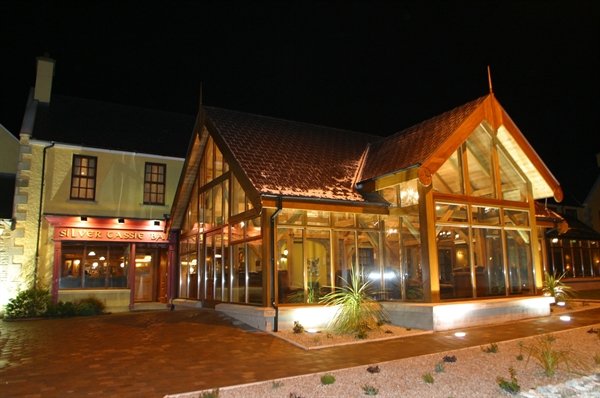![Shamrock pots for sale in Oxford]()
Shamrock pots for sale in Oxford
Last week we chatted about growing spuds for Christmas…and if that wasn’t worryingly forward thinking for some this week we’re chatting about sowing shamrock seed for next St Patricks Day.
Shamrock seeds (Trifolium dubium) can be sown from August- November indoors to get your own Shamrock for next March. The earlier you sow the bigger plants you’ll have. Sow thinly now into shallow seed trays, keeping indoors. Once establish pot up into small pots for growing on into larger specimens around January. These will then grow on into nice bushy plants, ideal for cutting (or selling!)![Shamrock]()
Shamrock seeds can be difficult to source, they’re strangely uncommon to see for sale in shops or garden centres. I’ve sourced these before from Seedaholic.com and Horkans.ie, both these sites sell on-line and a small pack will give you enough for around 6 button holes.
Trifolium dubium is a cousin of the common white clover which will grow in your lawn, and as such is easy to grow, requiring some fine soil to get going but then little or no feeding to keep them growing and looking lush.
White clover in the lawn is something which divides opinion amongst gardeners, those looking for a fine lawn will detest its appearance, and then there are gardeners who like the flowers, appreciate their attractiveness to bees and the likes and just let it be.
Whatever you think about it when its growing the conditions needed for clover to thrive in the lawn is low fertility, where you have ample Nitrogen in the soil the growth of clover will slow and the grass in the lawn will thrive, deplete the availability of Nitrogen and the growth of the grass will slow and the clover will thrive.
As mentioned before clover is mucho beneficial for bees and other beneficial insects so to have some flowering in the lawn has benefits to the wider biodiversity of the lawn (the flowers are completely edible and taste like peas), however to eradicate clover from a lawn is a tough process.
![New Polytunnel going up at the Twin Towns Community Garden]()
New Polytunnel going up at the Twin Towns Community Garden
Many of the lawn weedkiller products available aren’t strong enough to kill of the fleshy rhizome roots of the clover, a product like Hytrol Clover Lawn Weedkiller will be required. This product contains 2 strong active ingredients Mecoprop-P and Dicamba.
These two active ingredients are known as ‘selective’, in that they don’t damage grass, they just target broadleaf plants growing in grass. Mecoprop-P prohibits enzyme activity in plants, thus affecting plant growth. Taking 3-4 weeks to work fully and will leave residual affects in soil for 8 weeks. Mecoprop-P will kill a wide range of lawn weeds. Dicamba is the active ingredient which kills legumes, working like a growth hormone it makes the weed grow at an unsustainable rate, leading to plant death after 3-4 weeks. Dicamba will persist in soils for 1-4 weeks depending on how much organic matter is in your soil.
These 2 ingredients are best applied a few days after cutting the lawn, during times of growth (early summer to Autumn), and you may need more than one application where there’s heavy weed growth.
After application of any of these products it’s important that the lawn clippings aren’t added to the compost pile or mulched around plants. Both these ingredients can persist in the clippings and will affect the plants you add the compost or mulch too, leading to distorted growth in the garden.
Chemicals are patches, like painting over a damp wall. The wall is still damp, you’ve just hidden the problem. Where you have a lawn with heavy weed growth you need to create conditions that weeds don’t thrive in, so sort out your drainage, improve fertility, cut regularly and over-sow if needed to create a lush thick lawn, which will outcompete weeds.
Weeds will appear, as many will appear as airborne seeds from neighbouring gardens and bird seeds but as a gardener you have to decide what levels of weeds is tolerable to your lawn management and act appropriately.
After we keep mentioning slugs in previous weeks I was asked is there any plants that slugs don’t like, and yes there are many plants which slugs don’t like, won’t eat, or will only eat when they’re young or if there’s little else for them to eat.
A few Slug-proof plants I have in my own garden include Astrantia, Aquilegia, Bergenia, Crocosmia, Geraniums, Fuchsia, Euphorbia, Cosmos, Dephiniums and Astilbe. All these plants are nibbled but not madly consumed by Slugs, as mentioned before I keep a ‘tolerable’ level of slugs in the garden. You’re wasting your time and money trying to kill every slug, remember 85% live below the soil so you’ll never get them with ‘blue snow’ slug pellets. Far better to apply a light sprinkling every few weeks, and by a light sprinkling, remember 4/6 pellets around each plant is enough.
FEATURED GARDEN - TWIN TOWNS COMMUNITY GARDEN
![Gareth with some of the Twin Towns Community Group]()
Gareth with some of the Twin Towns Community Group
Our garden of feature this week is the Twin Towns Community Garden in Ballybofey. Established in March 2011 the garden has grown from having 30 raised beds to a thriving biodiversity habitat with 50+ raised beds, 2 Polytunnels and extensive community interest. The garden is located behind the Isaac Butt Building (the HSE offices in the car park beside McElhinneys store) and was an initiative of the Finn Valley Health Forum and the HSE. Since its conception in March 2011 the garden has developed into a hub of Horticultural learning in the Twin Towns area, with groups having completed FETAC Level 3 and Level 4 courses in Horticulture, umpteen hobby gardening courses, cookery programmes, health and well-being events….the list goes on!
A partnership approach between the Twin Towns Community Garden group, Mens Health programme and other organisations has seen the garden thrive in popularity and become largely financial independent – a Fund raising BBQ & car Boot Sale held on the 29th August creates funds for which the group uses again in the garden, a newly added polytunnel is a showcase of the success of the groups finances.
![Twin Towns Community Garden]()
Twin Towns Community Garden
The mix of users in the garden range from vastly experienced gardeners who use the raised beds to grow champion Beans, Roses, Tomatoes and the likes to total beginner gardens who benefit from the community spirit on the site and benefit from the support of the more experienced gardeners.
The Twin Towns Community Garden group operate a great Facebook page, so hunt them out if you live in the area, and they meet every Wednesday evening in the garden.
Next Week….Focus on Docks!
![Gareth Austin]()
Gareth Austin
Gareth Austin is resident Horticulturist with BBC Radio Foyle, a member of the Chartered Institute of Horticulturists and Horticultural Lecturer with the National Learning Network. For more see www.garethaustin.com or join Gareth on Twitter @GardenerGareth .
 The popular Tir na Nog bar in Letterkenny is celebrating its 10th birthday this weekend.
The popular Tir na Nog bar in Letterkenny is celebrating its 10th birthday this weekend.




























